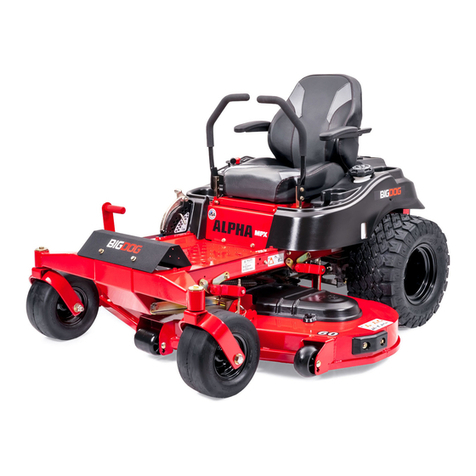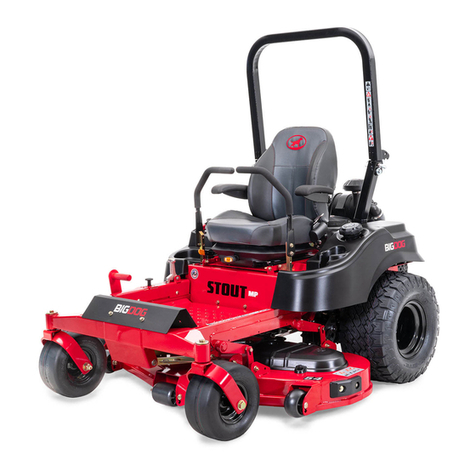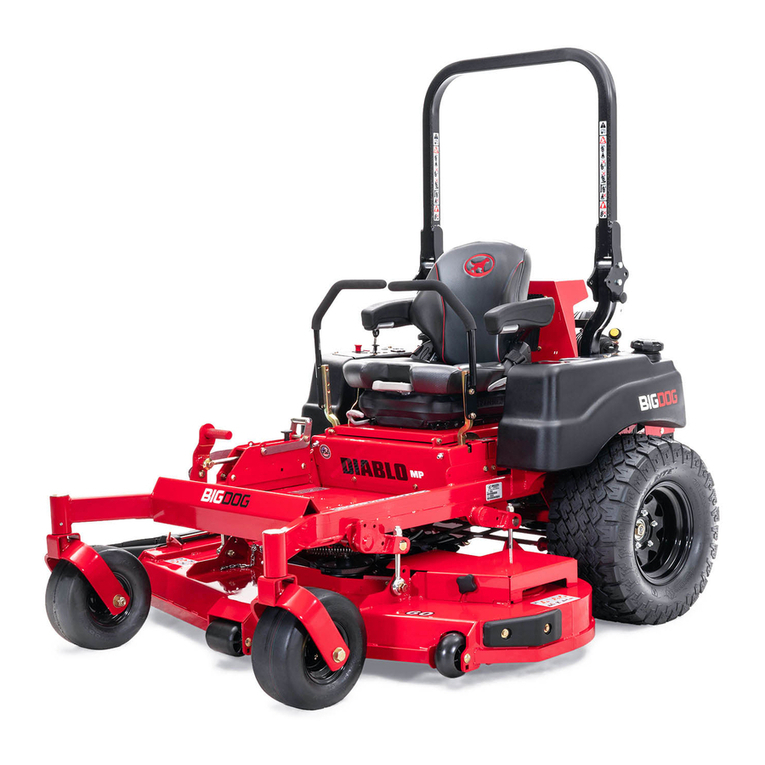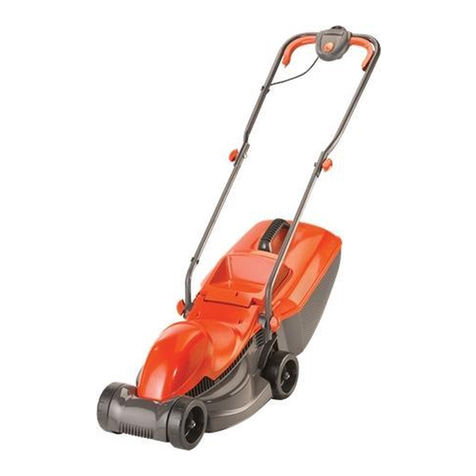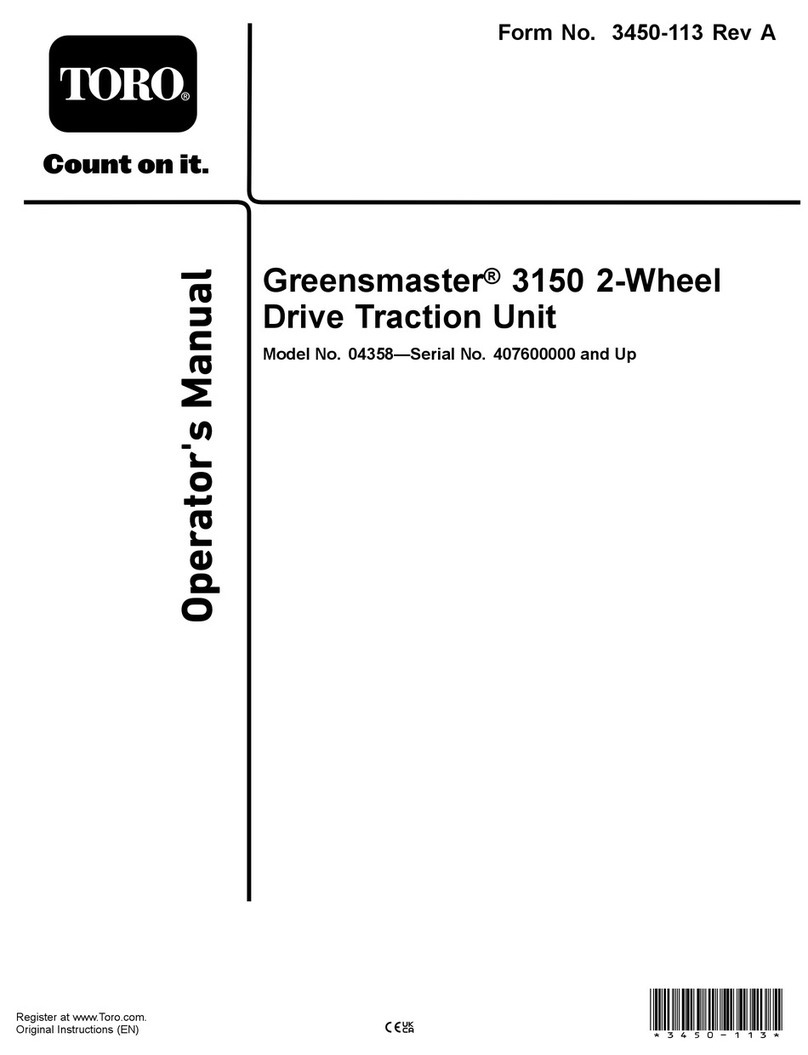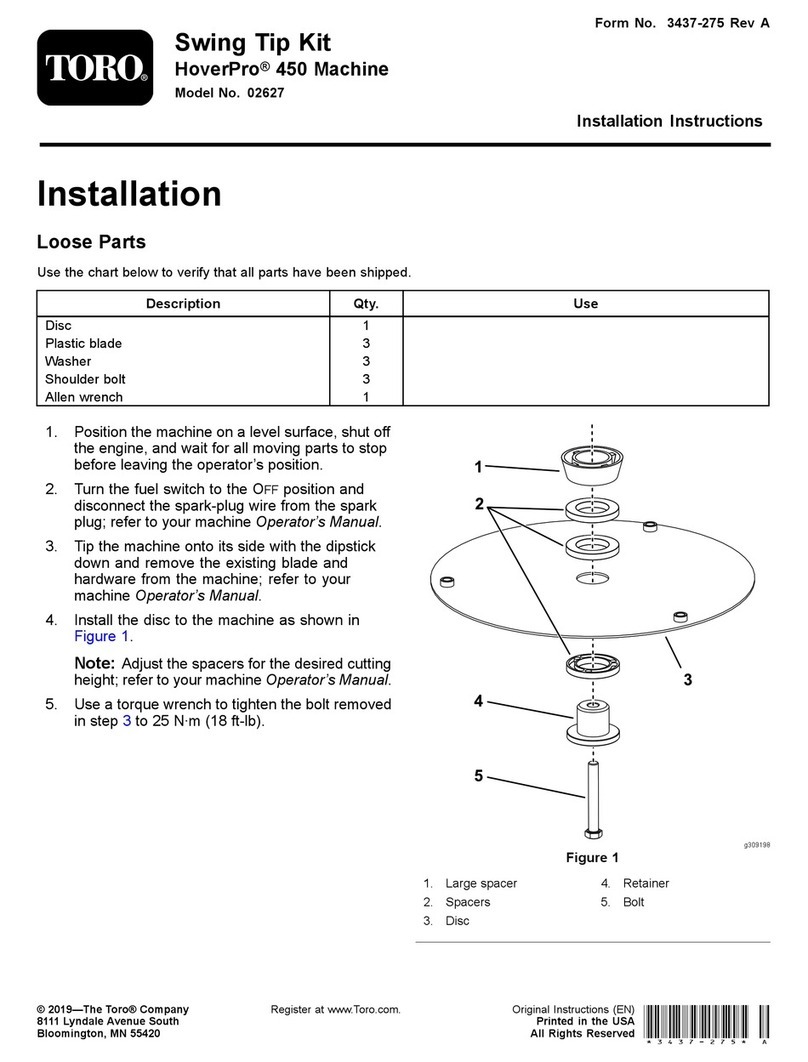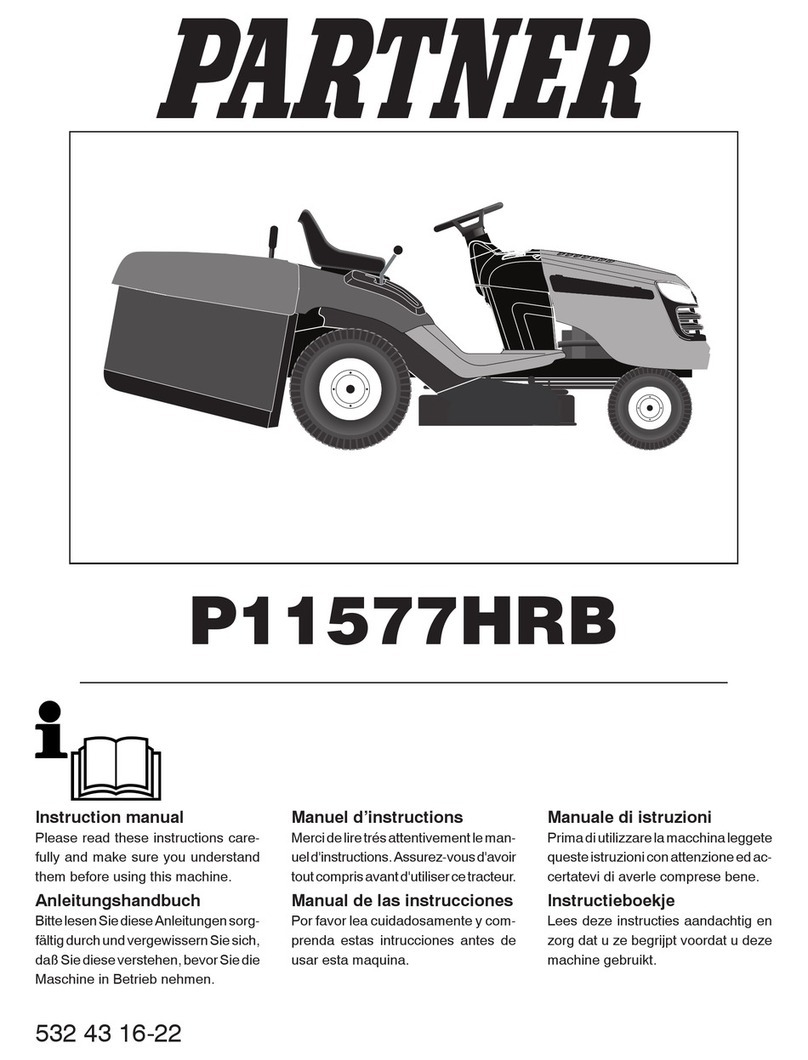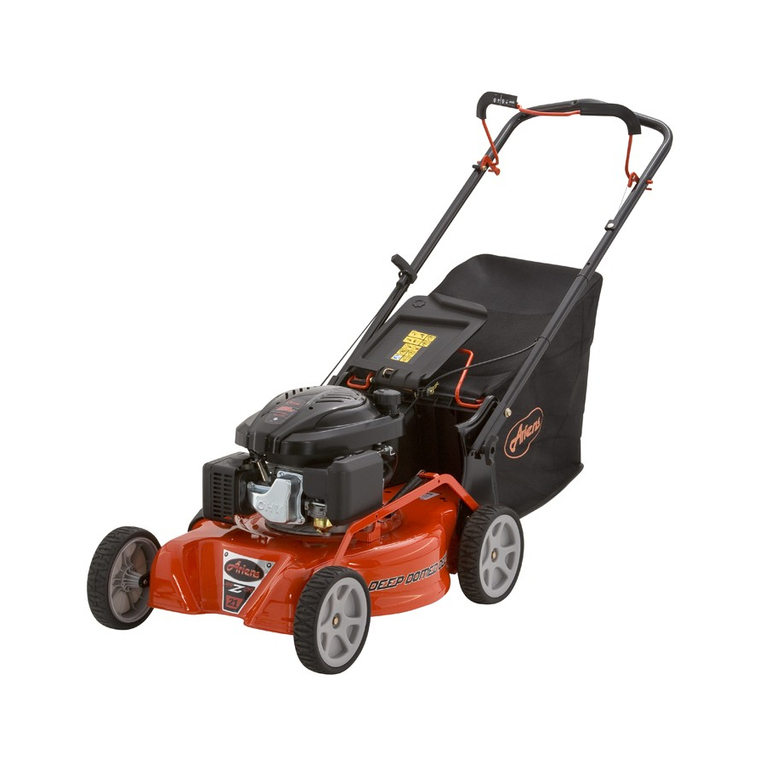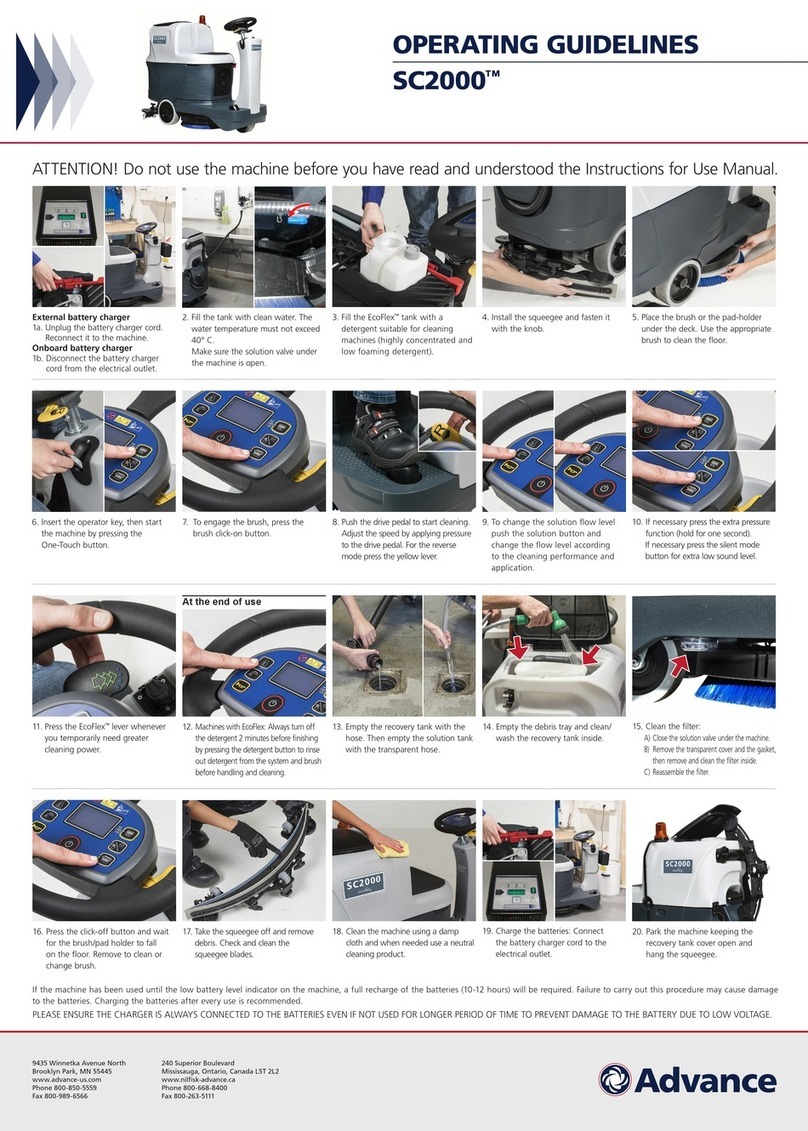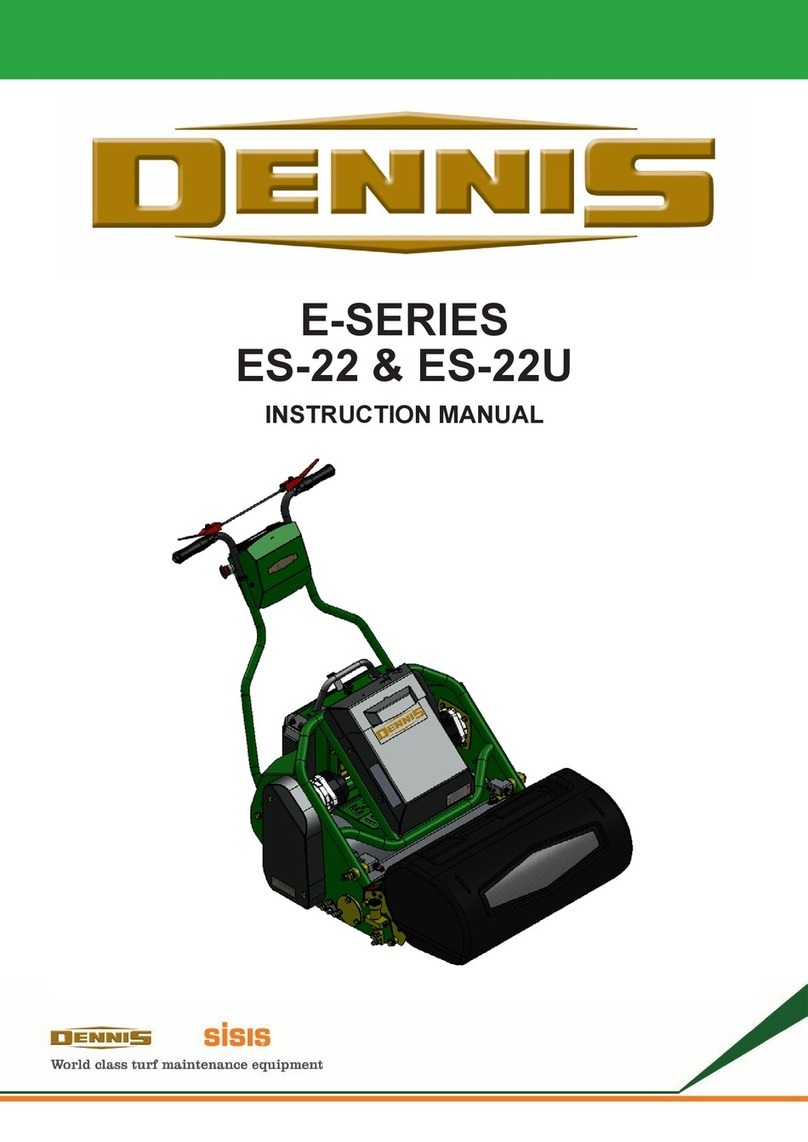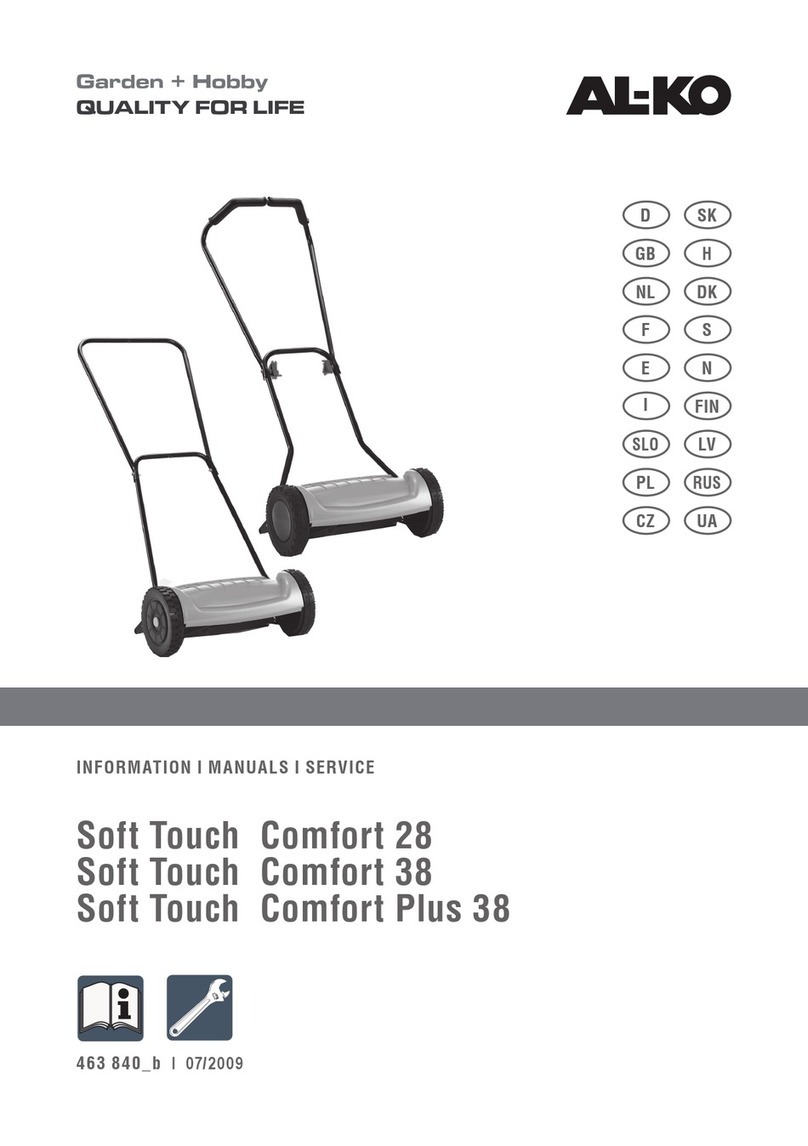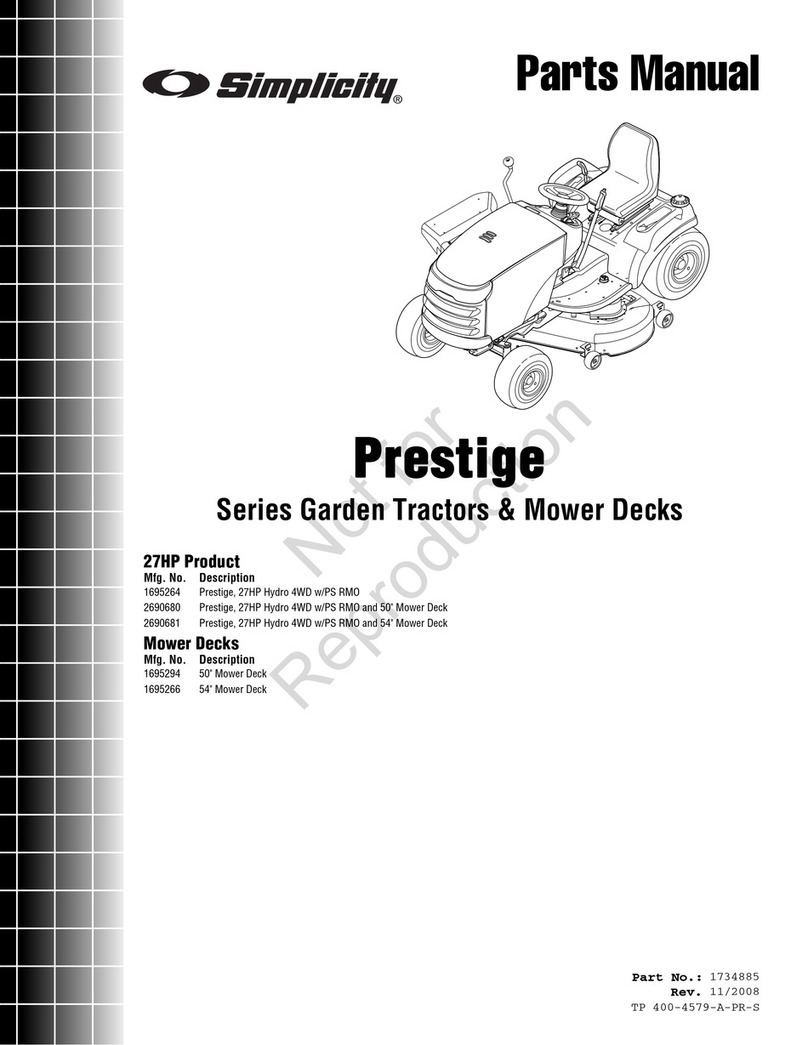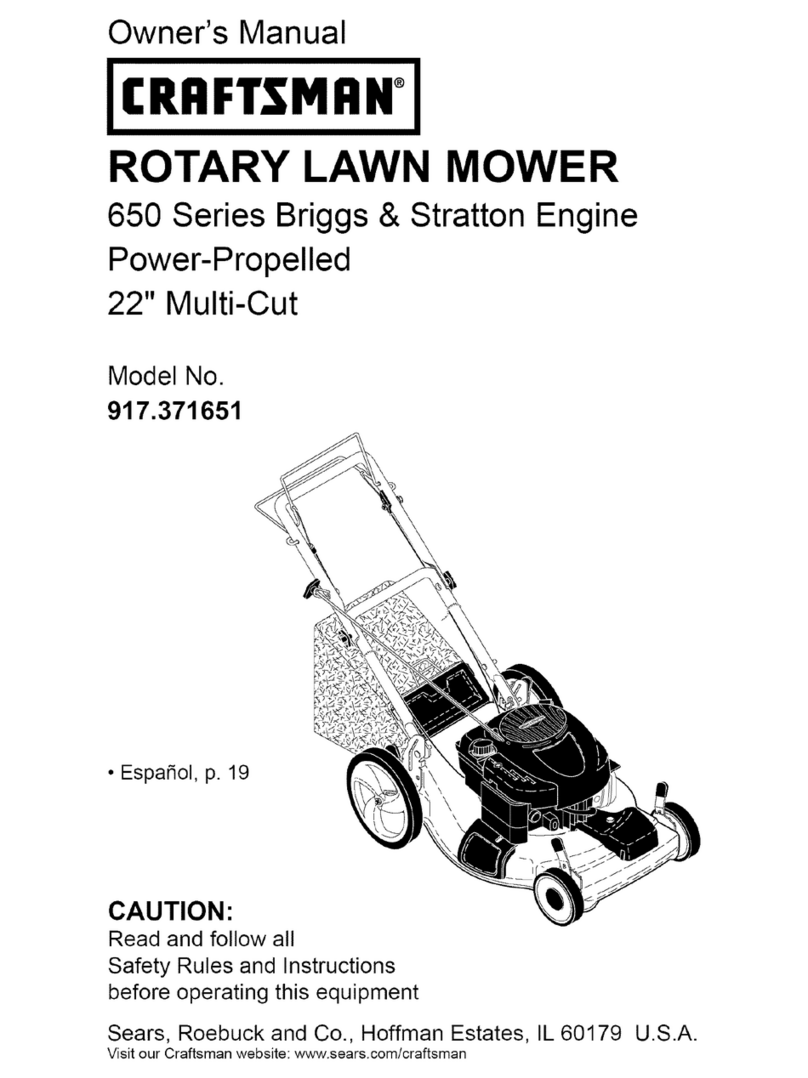BigDog Mower Alpha User manual

607233 REV A
BIGDOG®MOWER CO. Alpha®
Operator’s Manual
200 South Ridge Road
Hesston, Kansas
67062

The Engine Owner’s Manual provides information regarding the U.S. Environmental Protection Agency (EPA)
and the California Emission Control Regulation of emission systems, maintenance and warranty.
Keep Engine Owner’s Manual with your unit. Should the Engine Owner’s Manual become damaged or
illegible, replace immediately. Replacements may be ordered per the information found in the Product
Information section of the owner’s manual.
Federal law and California State law prohibit the following acts or the causing thereof:
1. The removal or rendering inoperative by any person other than for purposes of maintenance,
repair, replacement, of any device or element of design incorporated into any equipment for the
purposes of emissions control prior to or after its sales or delivery to the ultimate purchaser or
while it is in use, or
2. The use of the equipment after such device or element of design has been removed or rendered
inoperative by any person.
NOTICE OF REQUIREMENT OF SPARK ARRESTER MUFFLER
This equipment may create sparks that can start fires around dry vegetation. California Public Resources Code
Section 4442.6 provides that it is unlawful to use or operate an internal combustion engine on any forest-covered,
brush-covered, or grass-covered land unless the engine is equipped with a spark arrester maintained in effective
working order. A spark arrester is a device constructed of nonflammable materials specifically for the purpose of
removing and retaining carbon and other flammable particles over 0.0232 of an inch in size from the exhaust flow of
an internal combustion engine that uses hydrocarbon fuels or which is qualified and rated by the United States
Forest Service. Other states or federal areas may have similar laws. The Operator Should Contact Local Fire
Agencies For Laws or Regulations Relating to Fire Prevention Requirements. THIS EQUIPMENT DOES NOT HAVE
A SPARK ARRESTER AND YOU SHOULD CONTACT YOUR AUTHORIZED DEALER FOR THE PURCHASE OF
A SPARK ARRESTER.
Inspect spark arrester daily; replace every 500 hours or as needed.
WARNING
The engine exhaust from this product
contains chemicals known to the state
of California to cause cancer, birth
defects or other reproductive harm.
REV A 607233

607233 TOC-1 REV A
Table of Contents
General Information . . . . . . . . . . . . . . . . . . . . . . . . . . . . . . . . . . . . . 1-1
To the New Owner . . . . . . . . . . . . . . . . . . . . . . . . . . . . . . . . . . . 1-1
Using this Manual . . . . . . . . . . . . . . . . . . . . . . . . . . . . . . . . . . . . 1-1
Warranty Registration . . . . . . . . . . . . . . . . . . . . . . . . . . . . . . . . . 1-1
Model and Serial Number . . . . . . . . . . . . . . . . . . . . . . . . . . . . . . 1-1
Parts and Service . . . . . . . . . . . . . . . . . . . . . . . . . . . . . . . . . . . . 1-1
Safety Precautions . . . . . . . . . . . . . . . . . . . . . . . . . . . . . . . . . . . . . . 2-1
Safe Operating Practices . . . . . . . . . . . . . . . . . . . . . . . . . . . . . . 2-1
Service Precautions . . . . . . . . . . . . . . . . . . . . . . . . . . . . . . . . . . 2-4
Safety and Instructions Decals . . . . . . . . . . . . . . . . . . . . . . . . . . 2-6
Operation . . . . . . . . . . . . . . . . . . . . . . . . . . . . . . . . . . . . . . . . . . . . . 3-1
Safe Operating Practices . . . . . . . . . . . . . . . . . . . . . . . . . . . . . . 3-1
Control Panel . . . . . . . . . . . . . . . . . . . . . . . . . . . . . . . . . . . . . . . 3-1
Controls. . . . . . . . . . . . . . . . . . . . . . . . . . . . . . . . . . . . . . . . . . . . 3-1
Lights . . . . . . . . . . . . . . . . . . . . . . . . . . . . . . . . . . . . . . . . . . . . . 3-1
Safety Start Interlock System . . . . . . . . . . . . . . . . . . . . . . . . . . . 3-2
Starting the Engine . . . . . . . . . . . . . . . . . . . . . . . . . . . . . . . . . . . 3-3
Stopping the Engine . . . . . . . . . . . . . . . . . . . . . . . . . . . . . . . . . . 3-3
Moving the Mower With Stalled Engine . . . . . . . . . . . . . . . . . . . 3-3
Mower Operation . . . . . . . . . . . . . . . . . . . . . . . . . . . . . . . . . . . . 3-4
Deck Cutting Height Adjustment . . . . . . . . . . . . . . . . . . . . . . . . . 3-7
Anti-scalp Wheels . . . . . . . . . . . . . . . . . . . . . . . . . . . . . . . . . . . . 3-8
Maintenance & Adjustments. . . . . . . . . . . . . . . . . . . . . . . . . . . . . . . 4-1
Safe Servicing Practices . . . . . . . . . . . . . . . . . . . . . . . . . . . . . . . 4-1
Service Introduction . . . . . . . . . . . . . . . . . . . . . . . . . . . . . . . . . . 4-1
Torque Values. . . . . . . . . . . . . . . . . . . . . . . . . . . . . . . . . . . . . . . 4-1
Tires . . . . . . . . . . . . . . . . . . . . . . . . . . . . . . . . . . . . . . . . . . . . . . 4-1
Flex Fork® Break-In . . . . . . . . . . . . . . . . . . . . . . . . . . . . . . . . . . 4-1
Lubrication . . . . . . . . . . . . . . . . . . . . . . . . . . . . . . . . . . . . . . . . . 4-2
Electrical System . . . . . . . . . . . . . . . . . . . . . . . . . . . . . . . . . . . . 4-2
Hydraulic System . . . . . . . . . . . . . . . . . . . . . . . . . . . . . . . . . . . . 4-2
Fuel and Evaporative Emissions Control System . . . . . . . . . . . . 4-2
Fuel Evaporation System Filter. . . . . . . . . . . . . . . . . . . . . . . . . . 4-3
Engine Oil and Filter . . . . . . . . . . . . . . . . . . . . . . . . . . . . . . . . . . 4-3
Engine Air Filter . . . . . . . . . . . . . . . . . . . . . . . . . . . . . . . . . . . . . 4-4

REV A TOC-2 607233
General Engine Maintenance . . . . . . . . . . . . . . . . . . . . . . . . . . .4-4
Belts. . . . . . . . . . . . . . . . . . . . . . . . . . . . . . . . . . . . . . . . . . . . . . .4-4
Mower Blades . . . . . . . . . . . . . . . . . . . . . . . . . . . . . . . . . . . . . . .4-4
Seat Adjustment . . . . . . . . . . . . . . . . . . . . . . . . . . . . . . . . . . . . .4-6
Steering Control Lever Adjustment . . . . . . . . . . . . . . . . . . . . . . . 4-6
Troubleshooting . . . . . . . . . . . . . . . . . . . . . . . . . . . . . . . . . . . . . . . .5-1
Storage . . . . . . . . . . . . . . . . . . . . . . . . . . . . . . . . . . . . . . . . . . . . . . . 6-1
General Mower Preparation for Storage . . . . . . . . . . . . . . . . . . .6-1
Preparation of Engine for Storage . . . . . . . . . . . . . . . . . . . . . . . . 6-1
Preparation of Battery for Storage. . . . . . . . . . . . . . . . . . . . . . . .6-1
New Season Preparation. . . . . . . . . . . . . . . . . . . . . . . . . . . . . . .6-1
Product Literature . . . . . . . . . . . . . . . . . . . . . . . . . . . . . . . . . . . . . . . 6-3

607233 1-1 REV A
GENERAL INFORMATION
This manual applies to the following BigDog®Mowers
product lines:
BigDog®Alpha®
To the New Owner
BigDog®mower owners and operators must read this
manual carefully. It contains operation and maintenance
information that will help you achieve years of dependable
service.
The Engine Owner’s Manual, included in the owner’s
packet, contains engine information that will not be repeated
in this manual.
The owner’s responsibilities include, but are not limited to,
making certain that the operators and mechanics:
•read and understand the engine owner’s manual
before attempting to operate or repair the engine.
•read and understand the mower’s operator manual and
all decals before operating this machine.
•are qualified and physically able individuals, properly
trained in the operation and maintenance of this
equipment. Before they are allowed to operate or
maintain this machine, they must be familiar with its
safe operation, operator controls, and decals.
•know they are responsible for their own safety as well
as the safety of other persons within the vicinity.
Remember, the operator is responsible for accidents
or hazards occurring to other people or their property.
•who cannot read and understand English have this
material explained to them.
IMPORTANT: As the owner/operator you can prevent
accidents. You are responsible for accidents or injuries
occurring to yourself, other people or property.
Never let children or untrained people operate or service
the equipment. Local regulations may restrict the age of the
operator.
For more detailed maintenance and adjustment
information refer to the proper General Service Manual for
your machine. Refer to the Product Literature section of this
manual for information on how to obtain this manual.
Using this Manual
This manual contains general operation information as
well as basic adjustment and maintenance information.
Since operating conditions vary considerably, all conditions
cannot be addressed individually. Through training and
experience, operators should develop safe operating
practices suitable to most conditions.
Directions used in this manual, for example RIGHT or LEFT,
refer to directions when in the operator position and facing
forward, unless otherwise stated.
Though current at the time of printing, photographs and
illustrations shown may vary slightly from your mower due to
subsequent production changes. BigDog®Mower Company
reserves the right to redesign and change the machine as
deemed necessary, without notification. If a change has been
made to your machine which is not reflected in this manual,
contact your BigDog®Mower Dealer for current information.
Warranty Registration
To activate your warranty policy the mower must be
registered, by your Dealer, with the Manufacturer of BigDog®
mowers within ten (10) days following the date of purchase.
It is recommended that you contact your Dealer to make sure
the mower is registered.
IMPORTANT: The mower and any attachment that
displays a model and serial identification number plate must
be registered with Excel Industries, Inc., manufacturer of
BigDog®mowers (“Manufacturer”).
IMPORTANT: Any unauthorized modification, alteration,
or use of non-approved attachments voids the warranty and
releases Manufacturer from any liability arising from
subsequent use of this equipment. Do not use or operate any
attachment not approved by BigDog®Mower Company.
IMPORTANT: Damage caused by unauthorized
replacement parts is not covered by this warranty.
Manufacturer expressly excludes liability for defects or
damage caused by such 'unauthorized' articles or service.
Model and Serial Number
Mower model and serial numbers are found on the serial
identification plate, located on the left mower frame side rail.
These numbers are required when the unit is registered
with BigDog®Mowers. They will also assure you of the
correct service parts when replacement becomes necessary.
Parts and Service
Use original BigDog®Mower replacement parts, or parts
that are equivalent in overall performance, that are available
from your local BigDog®Mower Dealer. For prompt, efficient
service, always provide the following information when
ordering parts:
1. Correct part description.
2. Correct part number.
3. Correct model number.
4. Correct serial number.
All arrangements for warranty repair and service must be
handled through an authorized BigDog®Mower Dealer.

REV A 1-2 607233

607233 2-1 REV A
SAFETY PRECAUTIONS
This safety alert symbol is used to call attention to a
message intended to provide a reasonable degree of
PERSONAL SAFETY for operators and other persons during
the normal operation and servicing of this equipment.
This manual uses two other words to highlight information:
A. IMPORTANT – calls attention to special mechanical
information.
B. NOTE – emphasizes general information worthy of
special attention.
The owner’s responsibilities include, but are not limited to,
•making certain that the operators and mechanics read
and understand this manual and all decals before
operating this machine.
•making certain that before the operators and
mechanics are allowed to operate or maintain this
machine, they must be familiar with its safe operation,
operator controls, and decals.
•ensuring that the operators and mechanics know they
are responsible for their own safety as well as the
safety of other persons within the vicinity. Remember,
the operator is responsible for accidents or hazards
occurring to other people or their property.
Improper use, adjustment, or maintenance by the operator,
mechanic or owner can result in injury or death. Reduce the
potential for injuries by following these safety instructions.
Pay close attention to the safety alert symbol “” and the
instructions that follow it. Failure to comply with these
instructions may result in personal injury or death.
Incorrect usage of this equipment may result in severe injury
or death. Personnel operating and maintaining it should be
trained in its proper use. They should read this manual
completely and thoroughly before attempting to set-up,
operate, adjust, or service this equipment.
Safe Operating Practices
This product is capable of amputating hands and feet and
throwing objects. Always follow all safety instructions to
avoid serious injury or death.
Never allow persons to operate this mower without
proper instruction or allow children to operate the
mower. Allow only responsible adults who are familiar
with these instructions to operate this mower.
Safe Operation
Evaluate the terrain to determine what accessories
and attachments are needed to properly and safely
perform the job. Only use accessories and
attachments approved by the manufacturer.
•Do not use any unauthorized attachment or
modify the mower.
•Follow the manufacturer’s recommendation for
wheel weights or counterweights.
•If any attachment or additional weight is
mounted on the rear of the unit, any rapid
movement of the control levers in either direction
could result in a reaction of the mower that can
cause serious injury.
Do not use a catcher on any mower equipped with Flex
Forks®.
Always be alert and inspect area to be mowed for
hazards such as rocks, metal objects and other debris
which may be thrown or entangled by mower blades.
Remove these objects before mowing. Watch out for
holes or deep depressions.
Always operate mower in daylight or with adequate
working lights.
Never operate the mower when there is a risk for
lightning.
Personal Safety
Always wear long pants and safety shoes with slip-
resistant soles when operating this mower.
•Do not wear sandals, tennis shoes, sneakers,
shorts or any type of loose fitting clothing as they
may get tangled in moving parts.
•Do not wear a towel from the waist, or use a towel
as a headband or neck wrap.
•Long hair or jewelry may get tangled in moving
parts.
Always wear adequate ear protection, such as
earplugs. Prolonged exposure to loud noise can cause
impairment or loss of hearing.
– denotes immediate hazards which WILL result in
severe personal injury or death.
– denotes a hazard or unsafe practice which COULD
result in severe personal injury or death.
DANGER
WARNING

REV A 2-2 607233
•Do not wear radios or music headphones while
operating this mower. Safe operation requires
your full attention.
Always wear safety goggles or safety glasses with side
shields when operating this mower.
Do not operate the mower if you are fatigued, sick or
while under the influence of alcohol or drugs, if you are
pregnant or under 18 years old.
Poor posture or operating the mower for extended
periods of time may lead to fatigue or injury, resulting
in loss of mower control. Occasionally, stop the mower
and get off the seat to stretch and relax.
Data indicates that operators aged 60 years and above
are involved in a large percentage of riding mower-
related injuries. These operators should evaluate their
ability to operate the mower safely enough to protect
themselves and others from serious injury.
Operation
Never leave a running mower unattended. Before
leaving the operator’s seat for any reason, including
emptying the catcher or unclogging the chute:
•Always stop on level ground.
•Disengage the deck clutch.
•Place the steering control levers in the park brake
position.
•Stop the engine.
•Remove the ignition key.
•Wait for the engine and all moving parts to come
to a complete stop.
Always inspect mower for damage after striking a
foreign object. If damage is found, repair mower
immediately.
Always remain seated while operating the mower. Only
start the engine from the operator’s position.
Turn off the mower blades when not mowing.
Always keep safety shields and covers in place, except
for servicing.
•Never operate the machine with the floor plate
pulley cover removed.
Never operate the mower deck with the discharge
chute damaged, altered, removed, or in the raised
position, except when the entire grass catcher
attachment or mulching system is being used.
Always keep clear of the mower blades and
attachments during their operation.
•Never put hands or feet under any part of the
mower while it is running.
Stop the engine before removing the grass catcher or
unclogging the discharge chute. Never clear the
discharge chute with the engine running. Turn off the
engine and be sure the blades have stopped before
cleaning. Use a stick to clear a plugged discharge
area. Never use your hand!
Follow daily and weekly checklists, making sure hoses
are tightly secured and bolts are tightened.
•Never operate a poorly maintained mower.
Clean flammable material from mower. Prevent fires by
keeping the engine compartment, top of the deck,
exhaust area, battery, fuel line, fuel tank and operator’s
station clean of accumulated trash, grass clippings, and
other debris. Always clean up spilled fuel and oil.
Prevent fires by keeping the engine and exhaust areas
clear of grass clippings and other debris. Do not back
mower into flammable materials.
•Allow the mower, especially the engine, to cool
before storing inside a building.
Do not change the engine governor setting or over
speed the engine. Operating the engine at excessive
speed may increase the hazard of personal injury.
Rapid movement of the steering control levers in either
direction could result in a reaction of the mower that
can cause serious injury.
•Never push forward suddenly on your steering
control levers while the mower is in rearward
motion because mower may tip backwards.
•Never pull back suddenly on your steering control
levers while the mower is in forward motion.
Always be aware of what is behind the mower before
backing up. Never mow in reverse. Always look down
and behind before and while backing up.
•If mowing in reverse is unavoidable, push forward
slowly on the steering control levers and avoid
sudden movement.
Slow down before turning.
Never attempt high speed maneuvering, especially in
crowded or congested areas.
Always maintain a safe distance from people and pets
when mowing. Always stop mower if someone enters
the area.
Never carry passengers.
Never direct discharged material toward anyone. Avoid
discharging material against a wall or obstruction.
Material may ricochet back toward the operator.
Always disengage the mower blades and wait for them
to stop before crossing gravel drives, walks or roads.
Always observe traffic laws while driving mower from
one location to another. Watch for traffic when
operating near or crossing roadways.
•Use care when approaching blind corners,
shrubs, trees, or other objects that may obscure
your vision.
Using a Ramp
Exercise extreme caution when loading and unloading
a mower onto a truck or trailer with a ramp.
Use only a single, full width ramp; do not use individual
ramps for each side of the unit. Having a full width

607233 2-3 REV A
ramp provides a surface for the mower frame to
contact if the unit starts to tip backwards. It also
reduces the risk of a wheel going off and the mower
tipping over.
Do not exceed a 15 degree angle between the ramp
and the ground or between the ramp and the trailer or
truck.
Avoid sudden acceleration when on a ramp.
Slope Operation
Slopes are a major factor in loss-of-control and tip-over
accidents, which can result in severe injury or death. All slopes
require extra caution. If you cannot back the mower up the
slope or if you feel uneasy on the slope; do not mow it.
REMINDER: Only operate on slopes of 15 degrees or less.
Use extreme caution when operating on slopes.
•Be extremely careful changing directions on a
slope. Slow down.
•Do not operate where the mower could slip or tip.
•Turn slowly
•Turn on the most level part of the slope
•To maximize traction, it is better to turn the front
of the mower uphill, rather than downhill. If drive
tires lose traction, steering control is lost which
could cause serious injury or death.
•If it becomes necessary to turn downhill, turn
slowly and gradually, if possible.
Watch for holes, ruts, bumps, rocks or other hidden
objects. Uneven terrain could overturn the mower. Tall
grass can hide obstacles.
Remove obstacles such as rocks, tree limbs, etc.
Keep all movement on slopes slow and gradual. Do not
make sudden changes in speed or direction.
Avoid starting and stopping on a slope. If tires lose
traction, disengage the mower blades and proceed
slowly straight down the slope.
Mow a safe distance (minimum of 10 feet) away from
drop-offs, retaining walls, drainage ditches,
embankments, water, and other types of hazards to
avoid a wheel dropping over the edge or to avoid the
ground from breaking away. This will reduce the risk of
the mower suddenly rolling over causing serious injury
or death.
Use a walk behind, push mower or hand-held trimmer
on slopes and near drop-offs, retaining walls, drainage
ditches, embankments and water to avoid mower
rollover and serious injury or death.
Do not mow on wet grass. Slippery conditions reduce
traction which could cause sliding and loss of steering
control.
Do not tow on slopes. The weight of the towed
equipment may cause loss of traction and loss of
steering control.
Do not try to stabilize the mower by putting your foot
on the ground.
If the mower’s tires lose traction when operating on
slopes, disengage the blades, place the control levers
in the park brake position, stop the engine, remove
ignition switch key, and get help.
Never make sudden starts, stops, turns, or reverse
direction, especially when maneuvering on slopes. The
steering is designed for sensitive response. Rapid
movement of the control levers in either direction
could result in a reaction of the mower that can cause
serious injury.
Never stop suddenly while backing down slopes. This
action may result in a reaction of the mower that can
cause serious physical injury.
The BigDog® mower is capable of operating
horizontally (traverse) on moderately steep slopes.
When operating on slopes up to 15 degrees, be aware
of any conditions that may cause the mower drive tires
to lose traction resulting in a possible loss of control
of the mower. An operator should not operate on a
slope until he is thoroughly familiar with the
equipment.
Do not operate on slopes greater than 15 degrees.
Refer to the Slope Guide, when determining the degree
of slope to be mowed.
It is strongly recommended that the operator drive the
mower off of the slope, using extreme caution, if any
sign of loss of traction is detected. Wait until the
condition that caused the problem is resolved before
attempting to operate on the slope again.
Terrain conditions can affect traction resulting in
possible loss of control of the mower. Some of the
conditions to be aware of are:
•Wet terrain
•Depressions in the ground; i.e. holes, ruts,
washouts
•Mounds of dirt
•Soil type; i.e. sand, loose dirt, gravel, clay
•Grass type, density, and height
•Extremely dry conditions of grass
•Tire pressure
The attachments mounted to the mower will also
affect the way it handles on a slope. Be aware that
each attachment’s characteristics vary.
Another consideration to safe mowing on slopes is to
be aware of what is located at the bottom of the slope.
Extreme caution should be used when there is a
hazard located at the bottom of the slope. Some
examples are:
•Water; i.e. lake, river
•Cliffs, retaining walls
•Roads, highways

REV A 2-4 607233
•Buildings
•Rocks
These are just a few examples of situations when
caution must be used when operating on a slope.
There are many other possibilities too numerous to
mention. Just remember to always exercise extreme
caution when operating on any slope.
Children
Tragic accidents can occur if the operator is not alert to the
presence of children. Children are often attracted to the mower
and the mowing activity. Never assume that children will remain
where you last saw them.
Never leave the mower unattended with the ignition
key in the switch, especially with children present.
Children or bystanders may be injured if they attempt
to move or to operate the mower while it is
unattended. Always disengage the deck clutch, place
the control levers in park brake position, stop the
engine, and remove the ignition key when leaving the
operator’s seat.
Keep children out of the mowing area and under the
watchful care of a responsible adult other than the
operator.
Be alert and turn the mower off if children enter the
area.
Before and while backing, look behind and down for
small children.
Never carry children, even with the blades off. They
may fall off and be seriously injured or interfere with
safe mower operation. Children who have been given
rides in the past may suddenly appear in the mowing
area for another ride and be run over or backed over by
the mower.
Never allow children to operate the mower.
Never allow children or others in or on towed
equipment.
Use care when approaching blind corners, shrubs,
trees, the end of a fence or other objects that may
obscure vision.
Service Precautions
Unless specifically required, DO NOT have the engine
running when servicing or making adjustments to the
mower.
•Park the mower on level ground.
•Disengage the deck clutch.
•Place the steering control levers in the park brake
position.
•Lower the deck.
•Stop the engine.
•Remove the ignition key.
•Disconnect the negative battery cable.
•Wait for all movement to stop before adjusting,
cleaning or repairing.
•Repairs or maintenance requiring engine power
should be performed by trained maintenance
personnel only.
•To prevent carbon monoxide poisoning, operate
the engine in a well ventilated area only.
•Read and observe all safety warnings in this
manual.
Before working on or under the deck, make certain the
engine cannot be accidentally started.
Always keep belt covers on mower deck for safety as
well as for cleanliness except when changing or
checking the belt.
Use a stick or similar instrument to clean under the
mower making sure that no part of the body, especially
arms and hands are under the mower.
Always wear adequate eye protection when:
•servicing the hydraulic system.
•servicing the battery.
•grinding mower blades and removing
accumulated debris.
Never attempt to make any adjustments or repairs to
the mower drive system, mower deck or any
attachment while the mower engine is running or deck
clutch is engaged. Repairs or maintenance requiring
engine power should be performed by trained
maintenance personnel only.
Never work under the machine or attachment unless it
is safely supported with jack stands.
•Make certain machine is secure when it is raised
and placed on the jack stands.
•The jack stands should not allow the machine to
move when the engine is running and the drive
wheels are rotating.
• Use only certified jack stands. Use only
appropriate jack stands, with a minimum weight
rating of 2000 pounds (907 kg) to block the unit
up.
•Use in pairs only.
•Follow the instructions supplied with the jack
stands.
Exercise caution when releasing spring tension from
any of the belt idlers or when working with any of the
deck lift components.
Do not touch hot parts of machine.
Keep nuts and bolts tight, especially the blade
attachment bolts. Keep equipment in good working
condition.
Never tamper with safety devices. Check their proper
operation regularly.

607233 2-5 REV A
Grass collection system components are subject to
wear, damage and deterioration, which could expose
moving parts or allow objects to be thrown. Frequently
check components and replace with manufacturer’s
recommended parts, when necessary.
Exercise caution when working under the deck as the
mower blades are extremely sharp. Wrap the blade(s)
or wear gloves and use extra caution when servicing
them.
Use original BigDog®Mower replacement parts, or
parts that are equivalent in overall performance, that
are available from your local BigDog®Mower Dealer.
•The mower may not comply with the appropriate
safety standards if aftermarket parts,
accessories, or attachments are used.
Mower Blade Maintenance Precautions
Never attempt to straighten a bent blade by heating, or
weld a cracked or broken blade as the blade may break
and cause serious injury. Replace worn or damaged
blades.
Never work with blades while engine is running or deck
clutch switch is engaged (on).
Always wear adequate eye protection when grinding
mower blades.
Mower blades are sharp and can cut. Wrap the
blade(s) or wear gloves and use extra caution when
servicing them.
Battery Service Precautions
Battery posts, terminals, and related accessories
contain lead and lead compounds, chemicals known to
the State of California to cause cancer and
reproductive harm. Wash hands after handling.
Charge batteries in a well-ventilated open area, away
from sparks and flames. Unplug charger before
connecting or disconnecting from battery. Wear
protective clothing and use insulated tools.
Avoid skin and clothing contact with battery acid.
•Always wear eye protection when checking the
battery. Acid can cause serious injury to skin and
eyes. If contact occurs, flush area with clean
water and call a physician immediately. Acid will
also damage clothing.
•Do not drink the battery electrolyte.
•Do not allow open flame near the battery when
charging.
•Hydrogen gas forms inside the battery. This gas
is both toxic and flammable and may cause an
explosion if exposed to flame. Always disconnect
the negative (black) battery cable(s) before
disconnecting the positive (red) cable(s). Always
connect the positive (red) battery cable(s) before
connecting the negative (black) cable(s).
•Do not overfill the battery.
•Electrolyte may overflow and damage paint,
wiring or structure. When cleaning the battery,
use soap and water. Be careful not to get soap
and water into the battery. Clean the battery
terminals with a solution of four parts water and
one part baking soda when they become
corroded.
Shorts caused by battery terminals or metal tools
touching metal mower components can cause sparks.
Sparks can cause a battery gas explosion which will
result in personal injury.
•Prevent the battery terminals from touching any
metal mower parts when removing or installing
the battery.
•Do not allow metal tools to short between the
battery terminals and metal mower parts.
Incorrect battery cable routing could cause damage to
the mower and battery cables. This can cause sparks
which can cause a battery gas explosion which will
result in personal injury.
•Always disconnect the negative (black) battery
cable(s) before disconnecting the positive (red)
cable(s).
•Always connect the positive (red) battery cable(s)
before connecting the negative (black) cable(s).
Fuel Handling Precautions
To avoid personal injury or property damage, use
extreme care when handling gasoline. Gasoline is
extremely flammable and the vapors are explosive.
•A fire or explosion from gasoline can burn you
and others and can damage property.
Observe the usual gasoline handling precautions:
•Do not smoke while refueling. Extinguish all
cigarettes, cigars, pipes and other sources of
ignition.
• Do not remove fuel cap or fill tank with engine
running or while engine is hot. Clean up any
gasoline spills.
•If gasoline is spilled, do not attempt to start the
engine but move the machine away from the area
of spillage and avoid creating any source of
ignition until gasoline vapors have dissipated.
•Keep gasoline away from open flame or spark and
store machine away from open flame or spark or
pilot light such as on a water heater or
appliances.
•Refuel outdoors. Never refuel or drain the
gasoline from the machine indoors.
•Never attempt to start the engine when there is a
strong odor of gasoline fumes present. Locate
and correct the cause.
•Store gasoline in an approved container and keep
it out of the reach of children. Never buy more
than a 30-day supply of gasoline.

M
A
X
O
F
1
0
%
E
T
H
A
N
O
L
I
N
F
U
E
L
I
G
H
E
R
T
H
A
N
E
1
0
F
U
E
L
V
O
I
D
S
W
A
R
R
A
N
T
Y
H
REV A 2-6 607233
•Do not fill fuel containers inside a vehicle or on a
truck or trailer bed with interior carpets or plastic
truck bed liners. Always place gasoline
containers on the ground away from your vehicle
before filling.
•When practical, remove the machine from the
truck or trailer and refuel the machine with its
wheels on the ground. If this is not possible, then
refuel such machine on the truck or trailer using a
portable container and not a fuel dispenser
nozzle. If a fuel dispenser nozzle must be used,
keep the nozzle in contact with the rim of the fuel
tank or container opening at all times until
fueling is complete. Do not use a nozzle lock-
open device.
•Never use gasoline for cleaning parts.
•Read and observe safety precautions elsewhere
in this manual.
Gasoline is harmful or fatal if swallowed.
Avoid prolonged breathing of vapors.
•Long-term exposure to vapors can cause serious
injury and illness.
Keep gasoline away from eyes and skin.
•Keep face away from nozzle and fuel tank or fuel
container opening.
•If gasoline is spilled on clothing, change clothing
immediately.
Safety and Instructions Decals
The decals are designed to give the operator and mechanic
brief daily operational and service information. Use these
decals as an extension of this manual. Do not remove or
obliterate the decals. Replace unreadable or missing decals.
It is the owner’s responsibility to make certain that the
operators and mechanics read and understand all decals
before operating this machine.
The following illustrations show the safety decals that are
located on the mower. A brief explanation is shown to help
the operator understand the decal’s meaning.
Specific safety warning decals are located on the
equipment near the immediate areas of potential
hazards. Do not remove or obliterate these decals.
Replace them if they become non-readable.
WARNING
•Read Operator’s Manual and Safety Warning Decals before
attempting to operate this machine.
•Do not smoke while refueling.
•Do not remove the fuel tank cap or fill tank with engine running or
while the engine is hot.
•Allow engine to cool before storing machine inside a building.
•Store away from open flame or spark if there is fuel in tank.
•Clean up any gasoline spills.
•Do not refuel while in enclosed trailer or other enclosed areas.
•Maximum of 10% ethanol (E10) in fuel. Fuels with greater than 10%
ethanol, (such as E15, E20 and E85) voids warranty. Fuels with
greater than 10% ethanol are not approved for use and such illegal
use could cause equipment failure and pose a fire hazard.
Part Number 602041
WARNING:
Hot surface!
•Keep a safe distance from the machine.
Part Number 785139 & 785220
602041
785220C E
785139C E
Park brake position Park brake positionForward position
Reverse position

601815
601967
607233 2-7 REV A
DANGER: Battery Hazards!
Part Number 601815
•Do not overfill battery.
•Electrolyte may overflow and damage
paint, wiring or structure. When cleaning
the battery, use soap and water. Be
careful not to get soap and water into the
battery. Use soda mixed in water to
clean corrosion off the terminals.
•Always wear eye protection when
checking the battery, acid can cause
serious injury to skin and eyes. If contact
occurs, flush area with clean water and
call physician immediately. Acid will also
damage clothing.
•Avoid skin contact
with battery acid
•Do not allow open flame near the
battery when charging.
•Hydrogen gas forms inside the
battery. This gas is both toxic and
flammable and may cause an
explosion if exposed to flame.
Always remove the negative ground
first and replace it last.
WARNING: Fire!
Part Number 601967
•Clean flammable material from
machine. Prevent fires by keeping
engine compartment, top of deck,
exhaust area, battery, fuel line, fuel
tank and operator’s station clean of
accumulated trash, grass clippings,
and other debris. Always clean up
spilled fuel and oil.
WARNING: Thrown objects!
•Always maintain a safe distance from
people and pets when mowing.
•Always stop machine if someone enters
the area.
•Inspect area to be mowed for hazards
such as rocks, metal objects and other
debris which may be thrown or entangled
by mower blades. Remove these objects
before mowing.
Part Number 604222
DANGER:
Rotating blades, pulleys & belts
•Keep shields and covers in place
while machine is in operation.
•Keep hands, feet and clothing
away from rotating pulleys and
belts.
604222

604889
Part Number 604889
C
M
D
F
L
B
G
H
E
J
I
A
K
REV A 2-8 607233
WARNING: Thrown objects!
•Never operate the mower deck with side
deflector damaged, altered, removed or in
raised position, except when the entire
grass catcher attachment or mulching
system is being used.
Part Number 604221
DANGER:
Rotating blades, pulleys & belts
•Keep shields and covers in place
while machine is in operation.
•Keep hands, feet and clothing
away from rotating pulleys and
belts.
604221
A. Fast
B. Slow
C. Choke
D. Mower blade engage/disengage switch
E. Ignition switch - insert key
F. OFF
G. ON
H. Engine start position
I. Wear ear protection, eye protection and safety shoes
when operating this equipment.
J. Read Operator’s Manual before attempting to operate
this machine.
K. Before starting the engine:
• Read Owner’s Manual
• Disengage mower blades
• Place control levers in park brake position
L. For maximum electric clutch life engage at 1/2 - 3/4
throttle position.
M. For maximum electric clutch life disengage at low
throttle position.

1. Hold this sheet of paper in front of you. Make sure that Line A is horizontal.
2. Align Line B with a vertical surface such as pole, tree or building.
3. Fold the paper along the slope guide lines (C, D or E).
4. Align the closest slope guide line with the ground slope. This will give you a close estimation of the ground slope to
be mowed.
Slope Guide Lines
Line B
D (10o)
C (5o)
E (15o)
Line A
Slope Guide
Use this diagram when determining the degree of slope to be mowed.
607233 2-9 REV A

REV A 2-10 607233

607233 3-1 REV A
OPERATION
Safe Operating Practices
Refer to the Safety Precautions section of this manual for
operational and personal safety information.
Control Panel
A. Deck clutch switch (Figure 3-1) — this switch engages
the deck. Pull the switch up to engage and push the
switch down to disengage the clutch.
For additional clutch information refer to the Mower
Deck Operation section of this manual.
B. Ignition switch (Figure 3-1) — a three position switch:
“OFF”, “RUN”, and “START”. With the key inserted,
rotate it clockwise to the “START” position; release the
key when the engine starts, and the switch will auto-
matically return to the “RUN” position
C. Throttle control (Figure 3-1) — a cable is linked to the
engine throttle for controlling engine speed. Move the
lever forward to increase engine rpm, move the lever
rearward to decrease engine rpm.
D. Choke control (Figure 3-1) — a cable is linked to manu-
ally operate the engine choke. When the lever is in the
down position, the choke is in the “OFF” (run) position.
When the knob is pulled up, the choke is in the “ON”
(start) position. Do not operate the machine in the “ON”
(start) position.
Controls
A. Steering control levers (Figure 3-2 & Figure 3-3) —
these levers control the mower’s speed, direction,
stopping, and park brake.
B. Deck lift pedal (Figure 3-4) — the deck lift pedal is
used to raise or lower the deck. Push on the pedal to
raise the deck and then place the adjusting pin into the
desired cutting height hole. Release the pedal. Push
the deck lift pedal to raise the deck when going over
obstructions.
Lights
These mowers come equipped with operating lights
mounted in the front mower frame. There is no dedicated
“ON/OFF” switch for these lights. These lights come on when
the ignition switch is in the “RUN” position and go off when
the ignition switch is in the “OFF” position. Figure 3-5
A. Deck clutch switch
B. Ignition switch
C. Throttle
D. Choke
Figure 3-1
D
A
B
C
The parking brake may not hold the mower if
parked on a slope. Block or chock the machine
when parked on a slope.
Shown with steering control levers in the neutral position
A. Steering control lever
Figure 3-2
WARNING
A

REV A 3-2 607233
Safety Start Interlock System
The mower’s safety start interlock system consists of the
park brake switches, seat switch, and deck clutch switch.
IMPORTANT: Repair this important safety feature
immediately if it malfunctions.
This safety feature prevents mower runaway or accidental
entanglement during operation.
Check the mower’s safety start interlock system daily,
prior to operation.
To inspect the system:
1. Sit on the seat when testing the seat switch.
2. Set both steering control levers in the park brake
position.
3. Start the engine and allow it to warm up to operating
temperature.
4. With the deck clutch switch down and the steering
control levers in the park brake position, slowly rise off
of the seat. The engine should continue to run.
5. With the deck clutch switch up and/or the steering
control levers in the neutral position, slowly rise off of
the seat. The engine should stop.
6. If the engine fails to stop when:
•the deck clutch switch is up, or
•one or both of the steering control levers is in the
up (out of neutral position), and
•the operator is off the seat, then
•check the function of the seat switch. Replace
the seat switch if it is not operating properly (is
not opening or closing) and if the cause can not
be determined.
Shown with steering control lever in the park brake position
A. Steering control lever
Figure 3-3
A. Deck lift pedal
Figure 3-4
A
A
A. Lights
Figure 3-5
A

607233 3-3 REV A
If you cannot locate the problem contact your BigDog®
Mower Dealer.
Starting the Engine
The mower’s safety start interlock system is also designed
to protect the operator and others from accidental injury due
to unintentional engine starting. The engine starting motor
will not engage until:
1. Steering control levers are in the park brake position.
2. Deck clutch switch is in the down (OFF) position.
NOTE: The operator’s seat is equipped with a separate
safety switch. If for any reason the operator should become
unseated when the steering control levers are not in the park
brake position (park brake switches are disengaged) or the
deck clutch switch is engaged the engine will stop.
The following steps are the correct procedures for starting
the engine. If difficulty is encountered, contact the BigDog®
Mowers Dealer in your area.
1. Before starting mower each day, perform daily pre-
operation checking. (See Safety Start Interlock System
section.)
2. Make sure the steering control levers are in the park
brake position and deck clutch switch is disengaged.
Only start the engine from the operator’s position.
3. Use the choke, if the unit is equipped with one, when
engine is cold, or if warm engine fails to start within 5
seconds of cranking. Avoid flooding and operate
engine without choking as soon as possible.
4. Set throttle at approximately 1/2 open position.
5. Insert key in ignition switch and rotate full clockwise
to engage starting motor. Release key when engine
starts.
IMPORTANT: The engine starter should not be
operated for periods longer than 30 seconds at a time.
An interval of at least two minutes should be allowed
between such cranking periods to protect the starter
from overheating and burn-out.
6. Perform test to make sure safety start interlock
system is operating properly. Refer to Safety Start
Interlock System section.
7. Allow the engine to idle a few minutes before
advancing the throttle and/or engaging the deck
clutch.
Stopping the Engine
Use the following procedure to shut the engine off.
1. Place the steering control levers in the park brake
position.
2. Throttle the engine back to low idle, then disengage
the deck clutch. Refer to the Mower Deck Operation
section for more details.
3. Let the engine run at low idle for two minutes.
4. Rotate the ignition key counter-clockwise to the “OFF”
position. Remove the key from the switch before
leaving the mower.
Moving the Mower With Stalled Engine
The bypass valves on the transaxles allow the mower to be
moved if the engine quits working.
Before moving the unit, pull out on the bypass valve rod
(Figure 3-6) until the notch in the rod hooks over the edge of
the slot. This places the bypass valves in the disengaged
position.
Place the steering control levers in the neutral position, to
release the park brakes, so that the mower can be moved.
Do not tow the machine. Move it by hand or use a winch to
load onto a trailer for transporting.
Secure the mower, facing forward, when transporting on
another vehicle. Tie the mower down securely using straps,
chains, cables, or ropes. Both front and rear straps should be
directed down and outward from the machine.
IMPORTANT: Always make certain the two bypass valves
are returned to their operating position before running the
mower following repairs.
The safety interlock system should always
function per steps 4 and 5. If it does not function
properly, correct it immediately. Do not operate
machine without a properly functioning seat
safety switch.
The safety interlock system must not be
disconnected or bypassed. Doing so could cause the
machine to operate unexpectedly resulting in
personal injury.
WARNING
WARNING
Allow the engine exhaust manifold to cool before
engaging or disengaging the bypass valves. The
bypass valve rods are located close to the exhaust
system.
WARNING

REV A 3-4 607233
Mower Operation
Driving the Mower
After starting the engine, engage the steering control
levers and steer as follows:
To go forward, push the steering control levers forward an
equal distance. Figure 3-7
To go in reverse, pull the steering control levers rearward
an equal distance. Figure 3-7
To turn left, move the right steering control lever farther
forward from neutral than the left steering control lever.
To turn right, move the left steering control lever farther
forward from neutral than the right steering control lever.
Figure 3-7
Zero radius turn, move one steering control lever forward
and the other steering control lever back of neutral. This
allows the drive wheels to counter-rotate. Figure 3-7
To stop or decrease speed, move steering control levers to
neutral. When going forward pull back gently on steering
control levers. When going in reverse push forward gently on
steering control levers.
For emergency stops, when traveling forward or rearward,
place the steering control levers in the park brake position
immediately.
To make a three point turn to the right:
1. Move the left steering control lever farther forward
from neutral than the right steering control lever and
start the turn. Figure 3-8
2. Next, pull back on the steering control levers until they
pass neutral and the machine starts to go rearward.
Figure 3-8
3. Pull the right steering control lever farther rearward
from neutral than the left steering control lever until
the rear of the machine pivots around. Figure 3-8
4. Then, push the steering control levers forward until
they both pass neutral and the machine starts to go
forward. Figure 3-8
5. Push the left steering control lever farther forward
from neutral than the right steering control lever and
finish the turn. Figure 3-8
IMPORTANT: Damage to the hydraulic system
components may occur with rapid movement of the steering
controls.
To increase speed, increase the steering control lever’s
distance from neutral. The farther forward the steering
control levers are from neutral, the faster the mower will
travel forward. The farther back the steering control levers
are from neutral, the faster the mower will go in reverse.
Bypass valve rod shown in operating position
A. Bypass valve rod B. Slot
Figure 3-6
Never make sudden stops or reverse direction,
especially when maneuvering on a slope. The
steering is designed for sensitive response. Rapid
movement of the control levers in either direction
could result in a reaction of the mower that can
cause serious injury.
A
B
DANGER
When moving in the rearward direction push
forward gently on steering control levers and avoid
sudden movement. Any sudden movement could
cause the front of the mower to come off of the
ground resulting in possible loss of control,
causing serious injury or death.
Always be aware of what is behind the machine
before backing up. Do not mow in reverse unless
absolutely necessary. Always look down and
behind before and while backing up.
DANGER
WARNING
Table of contents
Other BigDog Mower Lawn Mower manuals
Popular Lawn Mower manuals by other brands

Poulan Pro
Poulan Pro PP1644J owner's manual

Snapper
Snapper ELP21502KWV, ELP21602, ELP2160 Safety instructions & operator's manual
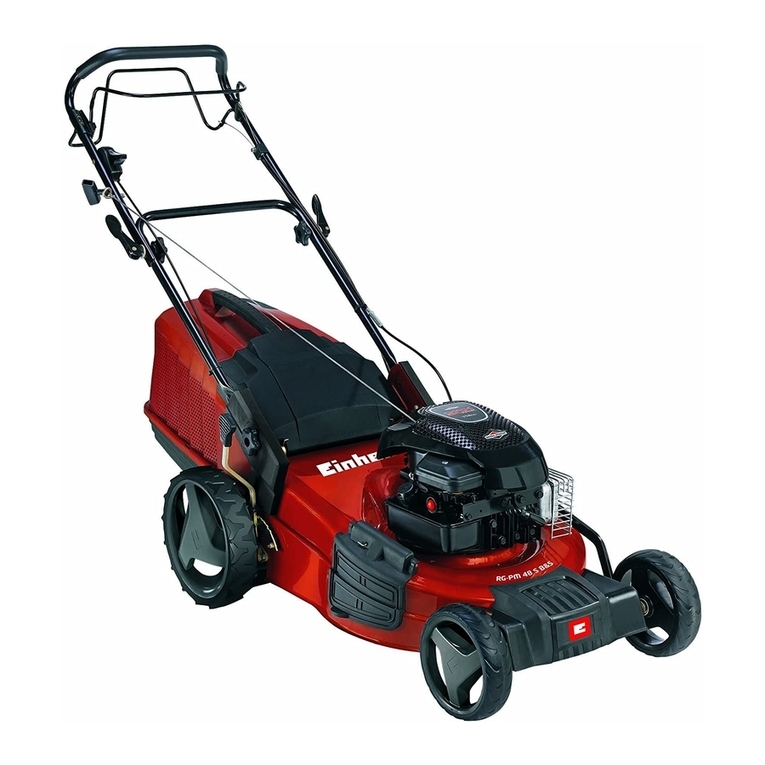
EINHELL
EINHELL RG-PM 48 S B&S Original operating instructions

Husqvarna
Husqvarna CTH2642TE Operator's manual
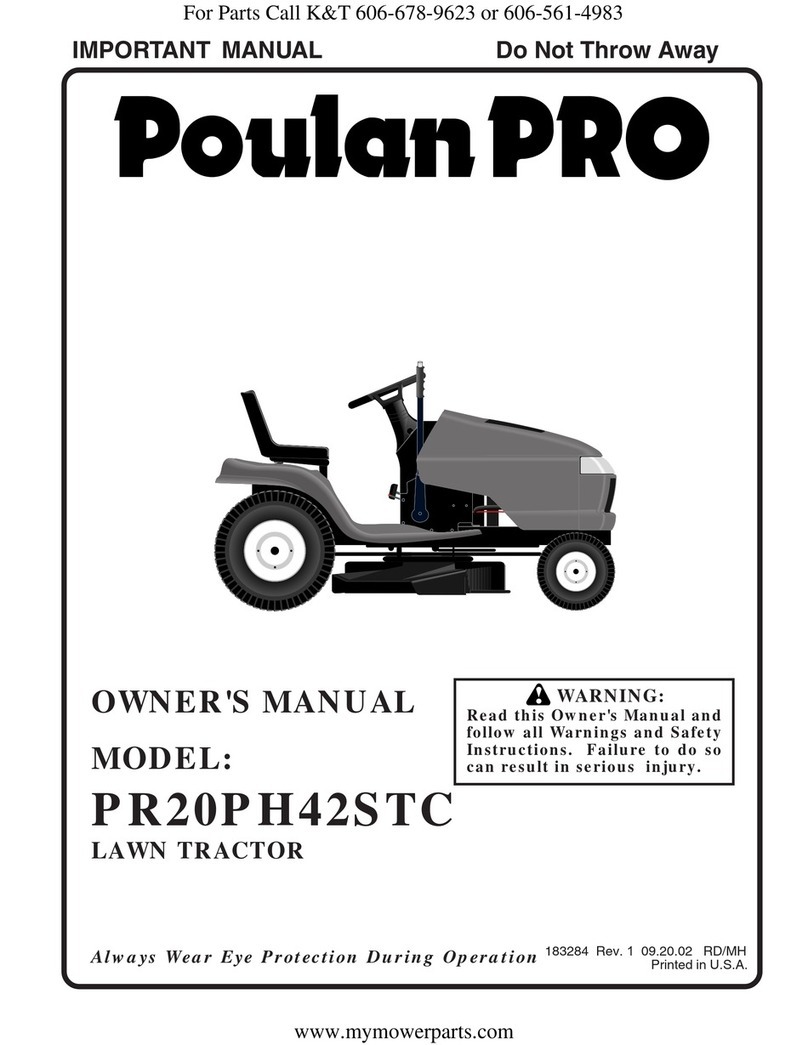
Poulan Pro
Poulan Pro PR20PH42STC owner's manual

Alamo
Alamo Bush Hog BH300 Series Operator's manual
